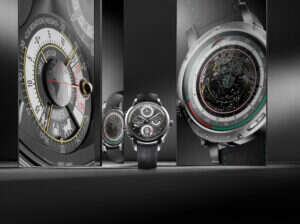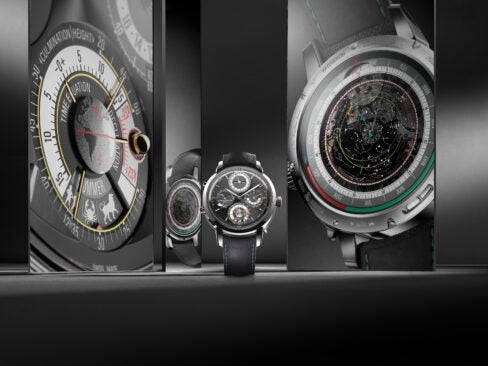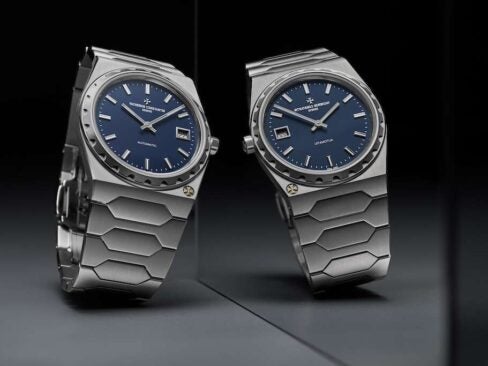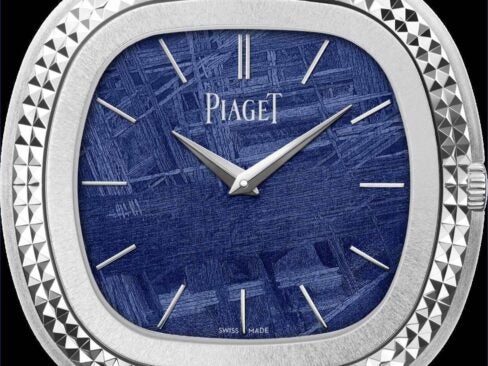By Zahra Al-Kateb
 The 14th Edition of the Grand Prix D’Horlogerie de Geneve is under way, and this year no less than 72 pre selected watches will be running to win the “Aiguille d’Or” Grand Prix.
The 14th Edition of the Grand Prix D’Horlogerie de Geneve is under way, and this year no less than 72 pre selected watches will be running to win the “Aiguille d’Or” Grand Prix.
With this year’s GPHG attracting record participation, all major watch groups are being represented, along with a number of independent companies.
Vote for your favorite amongst the following pre-selected watches and automatically participate in the drawing to win a Girard – Perregaux Vintage 1945 XXL Petite Seconde, worth $11372.29.
Here are the six finalists in the Artistic Crafts category.
CHANEL, COROMANDEL TWIN VOLUTE ENCHANTÉ
 The jewelry watch collection, entitled “Mademoiselle Privé”, opens the door to the intimate world of Gabrielle Chanel, and showcases her most cherished symbols and objects she loved to have around her.
The jewelry watch collection, entitled “Mademoiselle Privé”, opens the door to the intimate world of Gabrielle Chanel, and showcases her most cherished symbols and objects she loved to have around her.
Inspired by the lacquer Coromandel screens of Gabrielle Chanel’s appartment, this case containing two jewellery watches of the Mademoiselle Privé Coromandel collection faithfully adopts some of their sumptuous decorations. Reproduced in miniature, the dials of the two “Coromandel Twin” watches symbolise yin and yang, man and woman, light and shadow and the black and white that so faithfully represent CHANEL. As opposites are often complementary, this duality interprets the same aesthetic using two exceptional techniques, Grand Feu enamel and sculpted mother-of-pearl. The gold cases and crowns are adorned with snow-set diamonds and delicately showcase the unique design of each dial.
 CHAUMET, PRECIOUS WATCH ATTRAPE-MOI… SI TU M’AIMES
CHAUMET, PRECIOUS WATCH ATTRAPE-MOI… SI TU M’AIMES
Precious watches are inspired by nature; a nature that is stylised, touching and bucolic, expressing a different dimension of time, of movement, of emotion and celebrating the savoir-faire of jewellers, engravers, stone setters, sculptors, miniature painters and watchmakers who perpetuate and enrich the Maison’s watch collections. Each timepiece embodies the extraordinary dreams, creativity, technical ingenuity and jewellery expertise of Chaumet.
The Attrape-moi… si tu m’aimes collection expresses the Maison’s bestiary in a stunning performance of jeweller’s art: flowers, insects, butterflies and birds take the stage to tell miniature stories of love and seduction in a decor of luxuriant nature.
Six butterflies adorned with an intricate inlay of red carnelian, white wood and blackened gold seem to flutter on diamond-set rose gold stems. This uncluttered and detailed choreography is enhanced by a precious myrtle burl wood background.
The dial adorns a 35 millimetre rose gold watchcase that is set with diamonds. The bracelet, in coloured satin or white alligator with a rose gold diamond-set pin buckle, is attached to the two horns – their perfect perpendicularity underscores the design’s purity. Finally, the two hands are animated by a selfwinding mechanism featuring an oscillating mass that is engraved with the design of a dragonfly, a butterfly or a bee as an ultimate refinement…
The initial impulse that gave rise to the Art Piece Collection was generated by a desire to create points of convergence between the world of plastic arts and that of the art of watchmaking.
This is a ground-breaking new zone of expression that Greubel Forsey intends to share with artists whose aesthetic language is in resonance with its own universe.
The first physical interpretation of this philosophical approach, the product of our creative encounter with the British artist Willard Wigan, is quite simply spectacular. Willard Wigan is a sculptor who presents his works in galleries all over the world. His success comes on the one hand from the intrinsic quality of his creations, but also from their extraordinarily small dimensions.
These are micro-sculptures on such a tiny scale that they can only be admired with the aid of a microscope. His works take us on gripping journeys through the world of miniaturisation and invite us to discover and contemplate the minute details of which they are composed.
This shared passion focused on the absolute quality of each detail, both artistic and mechanical, is here expressed by creating a link between art and science. This link offers the owner of the Timepiece the ideal conditions in which to observe the dialogue created between the work of Willard Wigan and that of Greubel Forsey.
Installing a nano-sculpture within the confines of a timepiece yet enabling the wearer to admire its every detail without a microscope and despite the work being practically invisible to the naked eye.
Our R&D teams concentrated their attention on the only instrument identified (or at least the only one identified to date) that allows for ready examination of these micro-masterpieces: the microscope.
It was necessary to obtain a result that was visually perfect, offering all the qualities required (luminosity, magnification factor and focal length for clear vision) while ensuring the reliability and aesthetic appearance of the timepiece.
Starting from the basis of what existed from a theoretical point of view, our artisans, engineers and physicists took nearly four years to develop an exclusive miniaturised optical system, incorporating among other aspects an aspherical lens that meets requirements in terms of technical performance and reduced size.
The architecture of the mechanism was then totally refocused around the Double Tourbillon inclined at an angle of 30°, and then reworked so as to include an amphitheatre in which Willard Wigan’s work could find an ideal stage on which to be displayed.
Its geometry and its finishes were specially designed to obtain the maximum intensity of natural light around the stage. Its splayed shape enables the actual size of the artwork to be appreciated in relation to the surrounding features. A natural, poetic link is thus created with the micro-components making up this Greubel Forsey Timepiece.
Through its tenth anniversary, Greubel Forsey is consolidating its zone of expression and defines its new epigraph: “Art of Invention”.
Since the Atelier was founded, the creative capacity of Robert Greubel and Stephen Forsey has been a source of constant pleasure for lovers of exceptional timepieces throughout the world. The two inventor-watchmakers have already put their signatures to no fewer than six major inventions, leading to over 40 exclusive registered patents.
Another field in which they show their exceptional creative energy is the structure and architecture of their grand complications, purified among others through their Invention Piece creations.
A refusal to rest on their laurels, inventive boldness in both technical and aesthetic terms, and an insistence on craftsmanship born of a constant obsession with the concept of true quality: these are the essential hallmarks of all creative adventures bearing the Greubel Forsey signature.
Within its Arceau Millefiori models, Hermès encapsulates an unusual encounter between watchmaking and glassmaking. Its exceptional wristwatches and pocket watches, beating to the tune of mechanical calibres produced in the Swiss workshops of La Montre Hermès, are lit up by dials and covers inspired by 19th century paperweights, crafted by the Cristalleries royales de Saint-Louis.
Today, just as in the past, everything at Saint-Louis begins with the glass-melting furnace known as a pot furnace. The gatherer or ball-maker dips a punty (metal rod or blowpipe) into the mouth of these pots, each containing a colour of crystal or enamel, and twirls the molten matter to form a homogenous bubble-free mass known as a gob. Thus begins the patient work of the master glassmakers, performing a silent ballet known to them alone. The punty is passed on from hand to hand, from breath to breath and from workshop to workshop, until a monochrome crystal sprue is formed which will serve to create the canes that will in turn give rise to the ‘millefiori’ motif (a combination of Italian words meaning ‘a thousand flowers’).
Crafted by applying successive layers of crystal to enamel to reveal the colour, these canes resemble barley sugar candy canes. They are in some cases assembled to form ever-richer patterns. Whatever their colour or design, the process itself remains identical.
A glassworker takes a gob of molten crystal to which a second artisan applies his punty, before moving away as far as the temperature of the matter permits. He pulls or draws with him a several metre-long thread measuring just a few millimetres in diameter, and which will then be broken into several sections.
The canes thus created are cut into small ten-millimetre portions that are then vertically placed in a cast- iron bowl, where they form a bed of flowers. While one master glassmaker prepares a crystal ‘calotte’ or ‘skullcap’, the part that fixes it to the rod, a colleague brings him the bowl containing the millefiori. With the tip of his punty, the first artisan adds the molten clear crystal, fusing the two blocks so as to encapsulate or “package” the motif in glass. The punty then returns to the port opening in the furnace, and the material is worked with a shaping block or ladle-like wooden tool, meticulously fashioned with a wooden pallet – sometimes even with paper – to achieve the required shape. To set the finishing touch to the paperweight, the glassmaker creates a collar that will enable him to cut off the desired portion of crystal.
It is only during the final cutting stage that the crystal reveals the full wealth of its pattern and the unique beauty of the flowerbed with its vividly shimmering colours that will become the dial or cover of one of the Arceau models.
 JAQUET DROZ, PETITE HEURE MINUTE RELIEF SAISONS
JAQUET DROZ, PETITE HEURE MINUTE RELIEF SAISONS
In an expert blend of mastered skill by the Jaquet Droz craftsmen, the Petite Heure Minute Relief Seasons offers a new aesthetically-pleasing performance while reinventing tradition. The magnificence of birds, and especially the blue songbirds of his native Swiss Jura, has always captivated Pierre Jaquet-Droz. From the beginning, the watchmaker from La Chaux-de-Fonds has paid tribute to the fascinating and graceful crystalline song of these creatures using the most advanced techniques of the age to render the beauty of the plumage, the density of the colors, and the mysterious depth of their gaze.
For over 3 centuries, artistic crafts have been central to Jaquet Droz’s creative magic. Far from being merely ornamental, they personify the very spirit of the brand. More faithful than ever to this artistic world, the craftsmen of the Jaquet Droz Ateliers d’Art have once more surpassed themselves to create the Petite Heure Minute Relief Seasons, a timepiece that celebrates the enchantment of birds. Delicately positioned on either side of the dial, two blue songbirds spread their wings. Are they about to land? Or take to the air?
All the mystery of this scene resides in meticulously ordered craftsmanship: a dial is fashioned in hand-engraved mother-of-pearl, the birds are sculpted and engraved in gold before being applied to the dial and finally, the birds and the dial are painted– a miniature trompe-l’œil which comes to life in the hands of the brand’s craftsmen. From the curve of the wings to the size of the bodies, from the swell of the throat to the subtle association of the yellow and blue feathers, nothing has been omitted to make this truly three-dimensional masterpiece, saluting the beauty of nature and the freedom of these fascinating birds. The domed sapphire glass reinforces the optical illusion of the scene. When worn, it’s as if the whole of Nature is about to come to life, a reminder that the finest expression of life can be read in the passing of time.
VOUTILAINEN, HISUI
 One of the greatest lacquer studios of Japan, Unryuan, under the guidance of Mr. T. Kitamura, creates works of lacquer art that stand at the pinnacle of Japanese tradition, bringing a craft that has existed for hundreds of years into the present and exemplifying the passion to preserve the soul, spirit and identity of traditional Japanese culture as expressed in the Edo period. This kind of artwork made hundreds of years ago is with us still today. It can be restored and remains like new even when the lacquer is touched and manipulated by human hands. This superlative work engages us immediately on a physical level and one can only gape in awe at the commitment, patience and dedication involved in creating these works of art. The masterpiece shown here features lacquering techniques requiring well over a thousand hours of work to complete the dial and bridges. The raw materials for its creation are: Kinpun (gold dust), Jyunkin-itakane (gold leaf), Yakou-gai (shell of great green turban) and Awabi-gai (abalone shell from New Zealand).
One of the greatest lacquer studios of Japan, Unryuan, under the guidance of Mr. T. Kitamura, creates works of lacquer art that stand at the pinnacle of Japanese tradition, bringing a craft that has existed for hundreds of years into the present and exemplifying the passion to preserve the soul, spirit and identity of traditional Japanese culture as expressed in the Edo period. This kind of artwork made hundreds of years ago is with us still today. It can be restored and remains like new even when the lacquer is touched and manipulated by human hands. This superlative work engages us immediately on a physical level and one can only gape in awe at the commitment, patience and dedication involved in creating these works of art. The masterpiece shown here features lacquering techniques requiring well over a thousand hours of work to complete the dial and bridges. The raw materials for its creation are: Kinpun (gold dust), Jyunkin-itakane (gold leaf), Yakou-gai (shell of great green turban) and Awabi-gai (abalone shell from New Zealand).
This bespoke watch is inspired by Emerald and Jade precious stones, which is in fact what the name Hisui means.
This symbiosis of Japanese tradition with the Swiss haute horlogerie creations of Kari Voutilainen represents an all-embracing mechanical and visual work of art that unites East and West in perfect harmony.












